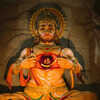 “श्रुति स्मृति पुराणानाम् आलयं करुणालयम् ।
नमामि भगवत्पादं शङ्करं लोकशङ्करम् ॥”
“श्रुति स्मृति पुराणानाम् आलयं करुणालयम् ।
नमामि भगवत्पादं शङ्करं लोकशङ्करम् ॥”
The scriptures often speak of the divine residing in every being, but few stories express this truth more beautifully than that of Hanuman. When Sita once asked Hanuman where Rama lived, he tore open his chest — and there, within his beating heart, were Rama and Sita, radiant and eternal. This moment was not meant to impress; it was meant to reveal something deeper: for Hanuman, devotion was not worshiping God outside, but carrying Him within.
The story symbolizes something that every seeker forgets — that the truest temple is not made of stone, but of surrender. Hanuman didn’t build shrines or chant to be seen; his devotion was silent, inward, and absolute. The image of Rama in his heart wasn’t a miracle of flesh, but a metaphor for consciousness — where love and duty dissolve into one being.
1. Because the Body Is Temporary, But the Heart Is Eternal

Hanuman Ji remains a symbol of resilience and protection. Temples and idols are sacred, but they exist in the realm of time. They can erode, be destroyed, or forgotten. But what Hanuman realized was that true worship cannot depend on what perishes. The heart, when purified of ego, becomes timeless. It becomes the seat of consciousness — the place where the Divine takes residence.
In the
Ramcharitmanas, Tulsidas calls Hanuman “Rama’s eternal servant.” This eternal bond wasn’t physical; it was spiritual. When the outer world fades, only what’s in the heart remains — and Hanuman made sure that space belonged to Rama alone.
2. Because True Bhakti Is Not Expression, But Absorption

Hanumans Sanjivani story in rhe ramayana Devotion is often mistaken for ritual. People sing, chant, and perform ceremonies, yet still seek validation. Hanuman’s bhakti, however, was
avyabhicharini — unwavering and selfless. He didn’t pray to please; he lived to serve.
In the
Bhagavata Purana, Krishna describes nine forms of devotion (
Navadha Bhakti), of which Hanuman embodied the highest —
Atma Nivedanam, complete self-surrender. He didn’t just love Rama; he ceased to exist apart from Him. His heart wasn’t a metaphorical temple — it was where his sense of “I” dissolved completely.
3. Because Hanuman Saw Rama Not as a Deity, But as Dharma

For Hanuman, Rama was not merely a god to worship, but the very embodiment of
dharma. Every action Hanuman took — from searching for Sita to carrying the mountain — was not for glory or recognition, but because it was the
right thing to do.
He never separated the divine from duty. His heart was a temple because it aligned perfectly with
Rama’s righteousness. Where the ordinary devotee asks for blessings, Hanuman only asked for strength to serve.
4. Because Devotion Without Ego Is the Purest WorshipHanuman’s humility was not weakness — it was realization. He once said to Rama, “When I think I am the body, I am your servant. When I think I am the soul, I am part of you. When I think I am beyond both, I am you.”
This is perhaps the most profound statement of spiritual evolution. The temple in his heart symbolized that he had transcended individuality. His
ego had vanished; only the reflection of Rama remained.
In essence, Hanuman didn’t carry an image of God — he carried the consciousness of God. His surrender made him divine himself.
5. Because External Temples Can Be Desecrated — the Inner One Cannot

Tuesday, rules by Mars, aligns with Hanumans courage and power The history of the world shows temples being built and destroyed. But the one place that no power can invade is the heart purified by devotion. Hanuman proved that the truest form of faith doesn’t depend on circumstances, politics, or fear.
His devotion was indestructible because it was inward. Even in chaos, even in exile, Hanuman remained connected. His mind didn’t need the sound of bells or the sight of idols; his remembrance itself was worship.
6. Because Love Is the Highest Form of KnowledgeIn the
Bhakti Sutras, Narada declares that devotion is not emotion, but
para vidya — supreme knowledge. Hanuman was a scholar, a warrior, and a yogi, yet all his wisdom bowed before love.
He realized that knowing Rama intellectually was meaningless unless one
felt Him completely. This is why his devotion moved beyond mantra and meditation — it became his very breath. The heart, the seat of feeling, thus became the temple where divine knowledge transformed into living experience.
7. Because Service Is the Path to the DivineHanuman’s devotion wasn’t passive; it was
seva, selfless service. He didn’t isolate himself to meditate; he acted tirelessly for Rama’s mission. This union of devotion and duty is what made his heart a living temple.
While sages worshiped in forests and kings built temples of gold, Hanuman built his through action. Every deed was an offering, every moment a prayer.
In the Gita, Krishna tells Arjuna that the highest yogi is one who performs all actions as offerings to God. Hanuman lived that truth centuries before it was spoken — his life was karma yoga perfected by bhakti.
8. Because He Represented the Bridge Between Human and Divine

Youre hidden until youre ready to be undeniable. Hanuman’s form — half-human, half-divine — is symbolic. It shows that every being has both instincts and intuition, body and spirit. By letting Rama reside in his heart, Hanuman bridged these two worlds.
He wasn’t worshiping something outside; he was realizing something within. In yogic philosophy, the heart center (
anahata chakra) is where duality dissolves. Hanuman’s open chest in that famous image signifies the ultimate yogic state — complete harmony between the physical and the divine.
9. Because His Faith Never Depended on ProofHanuman never questioned whether Rama was God. He didn’t need miracles, rewards, or assurances. His faith was not transactional — it was intrinsic.
In an age when devotion often depends on results, Hanuman’s love stands out because it existed without reason. He didn’t love Rama for who He was; he loved Him because he
couldn’t not. That kind of devotion can only come from within, not from any temple or teacher.
 “श्रुति स्मृति पुराणानाम् आलयं करुणालयम् ।
“श्रुति स्मृति पुराणानाम् आलयं करुणालयम् ।
 Hanuman Ji remains a symbol of resilience and protection. Temples and idols are sacred, but they exist in the realm of time. They can erode, be destroyed, or forgotten. But what Hanuman realized was that true worship cannot depend on what perishes. The heart, when purified of ego, becomes timeless. It becomes the seat of consciousness — the place where the Divine takes residence.
Hanuman Ji remains a symbol of resilience and protection. Temples and idols are sacred, but they exist in the realm of time. They can erode, be destroyed, or forgotten. But what Hanuman realized was that true worship cannot depend on what perishes. The heart, when purified of ego, becomes timeless. It becomes the seat of consciousness — the place where the Divine takes residence.
 Hanumans Sanjivani story in rhe ramayana Devotion is often mistaken for ritual. People sing, chant, and perform ceremonies, yet still seek validation. Hanuman’s bhakti, however, was
avyabhicharini — unwavering and selfless. He didn’t pray to please; he lived to serve.
Hanumans Sanjivani story in rhe ramayana Devotion is often mistaken for ritual. People sing, chant, and perform ceremonies, yet still seek validation. Hanuman’s bhakti, however, was
avyabhicharini — unwavering and selfless. He didn’t pray to please; he lived to serve.
 For Hanuman, Rama was not merely a god to worship, but the very embodiment of
dharma. Every action Hanuman took — from searching for Sita to carrying the mountain — was not for glory or recognition, but because it was the
right thing to do.
For Hanuman, Rama was not merely a god to worship, but the very embodiment of
dharma. Every action Hanuman took — from searching for Sita to carrying the mountain — was not for glory or recognition, but because it was the
right thing to do.
 Tuesday, rules by Mars, aligns with Hanumans courage and power The history of the world shows temples being built and destroyed. But the one place that no power can invade is the heart purified by devotion. Hanuman proved that the truest form of faith doesn’t depend on circumstances, politics, or fear.
Tuesday, rules by Mars, aligns with Hanumans courage and power The history of the world shows temples being built and destroyed. But the one place that no power can invade is the heart purified by devotion. Hanuman proved that the truest form of faith doesn’t depend on circumstances, politics, or fear.
 Youre hidden until youre ready to be undeniable. Hanuman’s form — half-human, half-divine — is symbolic. It shows that every being has both instincts and intuition, body and spirit. By letting Rama reside in his heart, Hanuman bridged these two worlds.
Youre hidden until youre ready to be undeniable. Hanuman’s form — half-human, half-divine — is symbolic. It shows that every being has both instincts and intuition, body and spirit. By letting Rama reside in his heart, Hanuman bridged these two worlds.